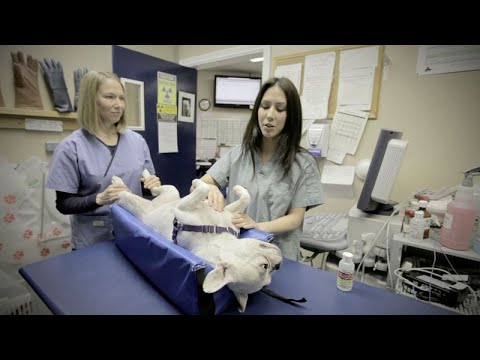Career Overview
Animal health technologists and veterinary technicians provide technical support to veterinarians by caring for animals and assisting in the diagnosis and treatment of animal health disorders. Animal health technologists and veterinary technicians who are supervisors are included in this unit group.
People in this occupation:
- May conduct medical laboratory tests, set up, clean and maintain medical laboratory equipment, as well as collect and prepare specimens for testing
- Work in veterinary clinics, animal hospitals, animal shelters, humane societies, zoos, animal research laboratories, pharmaceutical companies and government
- Should enjoy working with animals
- Should also be able follow direction and conduct medical tests
- Must be process oriented and understand the importance of following procedures
- Should be detail oriented
- Should have good computer skills
Job Titles
Duties
Veterinary and animal health technologists and technicians perform some or all of the following duties:
- Provide nursing care and rehabilitation therapy for animals
- Handle, restrain and care for animals undergoing treatment and surgery
- Produce radiographs, collect samples and perform other laboratory tests to assist in diagnosis of animal health problems
- Assist veterinarian with animals before, during and following surgery
- Prepare surgical equipment, give and monitor anesthetics, and clean up after surgery
- Prepare and give medications and vaccines under direction of veterinarian
- Give treatments as prescribed by a veterinarian
- Provide wound and bandage care
- Do specialized procedures such as animal identification and hoof trimming
- Talk to clients about animal health care including nutrition and home care
- Do laboratory research
- Do routine animal dental procedures, and help veterinarians with animal dentistry
- May do various office management and clerical duties
Earnings
Earnings is income that workers receive in exchange for their labour. Depending on the type of employment, earnings can be in the form of wages (hourly), salaries (fixed monthly or annual) or self-employed earnings.
Work Environment
# Workers Employed
3,115% Employed Full Time
53%Full-time veterinary and animal health technologists and technicians work 40–50 hours per week. They work indoors in veterinary clinics, which are often noisy. Emergency call-out work may sometimes be required.
Stress is often associated with treating abused animals or putting down animals. The work can also be physically demanding since veterinary and animal health technologists and technicians have to lift, hold or restrain animals, risking bites or scratches. Safety precautions reduce risk of injury.
Workers may also feel a sense of accomplishment in caring for the animals.
Career Pathways
With experience, veterinary and animal health technologists and technicians may progress to supervisory positions.
Occupational Interests
It’s important to understand what kinds of occupations align with your interests.
For more about occupational interests visit Skills for the Future Workforce > Characteristics.
Here are the top occupational interest(s) for this career profile:
Education, Training and Skills
Completion of a two- or three-year veterinary or animal health technology diploma or a related program is required.
In B.C., registration with the British Columbia Veterinary Technologists Association (BCVTA) is available to veterinary and animal health technologists who have completed an accredited training program and passed the Veterinary Technician National Examination (VTNE). For more information, please see the BCVTA website at https://www.bcvta.com/
Education programs in B.C.

Top Skills
Every job calls for a certain set of skills. Knowing those skills is the first step in finding a good career fit.
Here, you will find the 10 most relevant workplace skills. Some are more important to achieving success in a certain career than others. These skills may come naturally to you or you may need to gain them through education, training and experience.
See the list of work-related skills below, ranked in order of importance for this career. Check out the list and see if this career matches your skills—take that first step!
Giving full attention to what other people are saying, taking time to understand the points being made, asking questions as appropriate, and not interrupting at inappropriate times.
Using logic and reasoning to identify the strengths and weaknesses of alternative solutions, conclusions or approaches to problems.
Understanding written sentences and paragraphs in work-related documents.
Talking to others to share information effectively.
Keeping track of and assessing your performance, other individuals, or organizations to make improvements or take corrective action.
Communicating effectively in writing as appropriate for the needs of the audience.
Actively looking for ways to help people.
Being able to solve novel, ill-defined problems in complex, real-world settings.
Adjusting actions in relation to others' actions.
Being aware of others’ reactions and understanding why they react as they do.
Labour Market Statistics
Discover data, facts and information that have been gathered and analyzed. Learn about the characteristics of the economy and labour market in B.C.
Employment
Find out about employment types and trends by region and industry.
Employment
3,115Employment by Region







| Region | Employment | % Employment of this Occupation |
|---|---|---|
| Cariboo | 60 | 1.9% |
| Kootenay | 80 | 2.6% |
| Mainland/Southwest | 1,740 | 55.9% |
| North Coast and Nechako | 35 | 1.1% |
| Northeast | 30 | 1.0% |
| Thompson-Okanagan | 470 | 15.1% |
| Vancouver Island/Coast | 690 | 22.2% |
Labour Market Outlook
The B.C. Labour Market Outlook is a 10-year forecast of the expected supply and demand for labour in the province. It’s usually updated every year. The purpose is to provide British Columbians with the knowledge to make informed decisions on careers, skills training, education and hiring.
Forecasted Job Openings (2025-2035)
1,160Forecasted Job Openings
Forecasted Employment Growth Rate
Composition of Job Openings
Job Openings by Region (2025-2035)







| Region | Job Openings | Avg. Annual Employment Growth |
|---|---|---|
| Cariboo | 10 | 0.0% |
| Kootenay | 10 | 0.5% |
| Mainland/Southwest | 500 | 0.8% |
| North Coast and Nechako | 0 | -1.3% |
| Northeast | 10 | 3.6% |
| Thompson-Okanagan | 230 | 2.5% |
| Vancouver Island/Coast | 400 | 2.5% |
Industry Highlights
Learn about the opportunities in B.C.'s major industries, including employment trends, earning potential, locations of work and more.
Forecasted Job Openings by Industry
| Industry | Job Openings (2025-2035) |
|---|---|
| Professional, Scientific and Technical Services | 1,130 |
| Educational Services | 10 |
| Repair, Personal and Non-Profit Services | 10 |
| Health Care and Social Assistance | 10 |
Insights from Industry
Many new openings will result from the need to replace those who retire.
Spending on veterinary services has doubled over the last 10 years due to the increasing number of pets in North America, as well as the fact that more pet owners consider their pets to be a member of the family. Pet owners are more willing to spend money for involved veterinary procedures to extend the life of their animals. This trend is creating an increased demand for veterinary services, and is increasing job opportunities for veterinary and animal health technologists and technicians.
Recent outbreaks of diseases in farm animals, such as avian influenza and bovine spongiform encephalopathy, are also increasing the demand for veterinary diagnostic services and the services of veterinary and animal health technologists and technicians.
Resources
-
British Columbia Veterinary Technologists Association (BCVTA)bcvta.com
-
Canadian Animal Assistance Team (CAAT)www.caat-canada.org
-
Canadian Association of Animal Laboratory Sciencewww.calas-acsal.org
-
Canadian Council on Animal Care (CCAC)www.ccac.ca
-
Canadian Veterinary Medical Association (CVMA)canadianveterinarians.net/index.aspx
-
College of Veterinarians of British Columbia (CVBC)cvbc.ca
-
International Veterinary Nurses and Technicians Association (IVNTA)www.ivnta.org
-
Registered Veterinary Technologists and Technicians of Canada (RVTTC)beta.rvttcanada.ca








